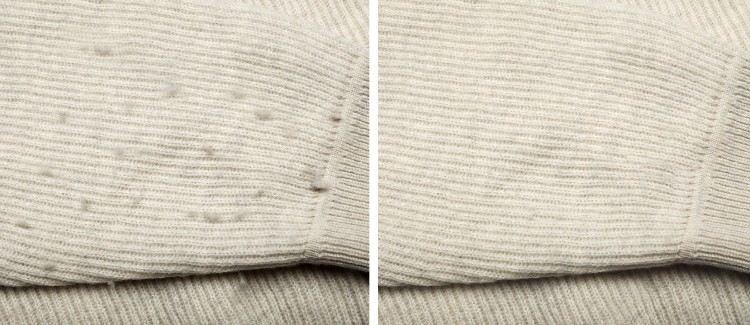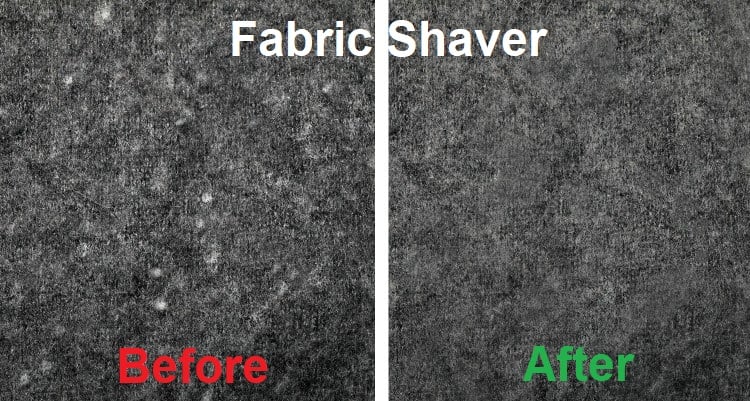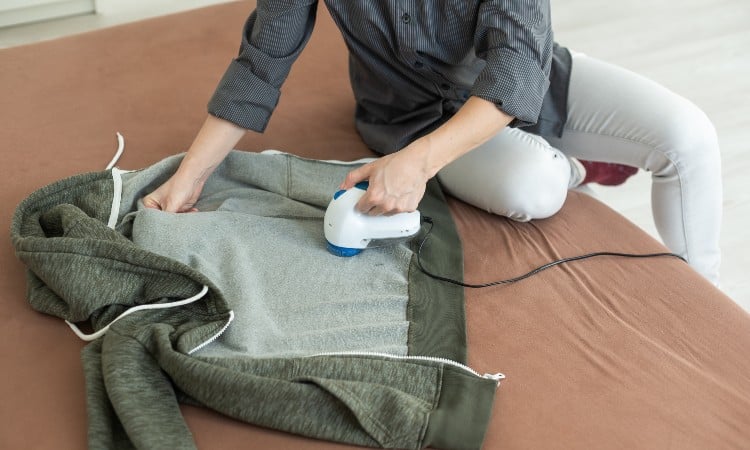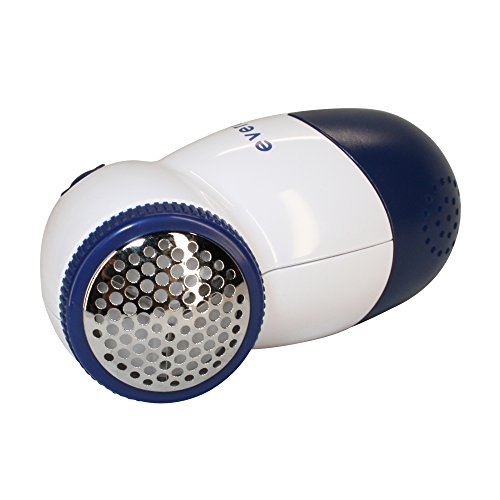Have you ever sat down in your office at work first thing in the morning, looked down at yourself, and realized that your favorite sweater has messy-looking pilling all over it? Many fabric types will pill over time as the tiny fabric fibers on the surface break and rub together. The good news is that you can learn how to remove pilling from clothes with a few simple tools!
The easiest way to remove pilling from clothes is to use an electric clothes shaver or a handheld safety razor. Other popular methods include using a special pilling comb to lift away any bobbles from the surface of the fabric. Sandpaper sponges or pumice stones can also remove pilling from clothes.
In this article, you will find out what causes pilling on clothing. You will learn six simple methods for getting rid of these ugly bobbles. Finally, you will find out how to prevent pilling as you care for your clothes.

Quick Navigation
- What Is Fabric Pilling?
- What Causes Pilling On Clothes?
- How to Remove Pilling From Clothes: 6 Methods
- Do Fabric Shavers Ruin Clothes?
- How To Remove Fuzz Balls From Sweaters?
- Does Polyester Pill?
- What Fabric Pills the Most?
- How to Prevent Pilling on Clothes
- How To Get Rid Of Pilling On:
- Best Fabric Pilling Remover
- Conclusion
What Is Fabric Pilling?
Fabric pilling is the formation of tiny thread balls on the fabric’s surface caused by loose fibers breaking free from the material. People also call fabric pills bobbles or fuzzballs. Pilling does not necessarily harm clothing or other fabric surfaces, but it does look bad.
In general, pilling on a garment makes it look worn-out and unattractive. Pilling on upholstery can also discolor and look dirty. Sweaters and trousers can develop severe pilling over time, leaving you with a garment covered in tiny nubs of hard thread.
Besides looking worn-out, clothes with serious pilling may begin to feel uncomfortable as the fabric’s surface grows rougher and bumpier.
Because of this, you probably want to find a safe way to remove pilling from any fabric surface!
What Causes Pilling On Clothes?

Laundering is usually the primary cause of pilling on clothes, though general wear and tear can also have an impact. This happens because the friction and agitation in a washing machine and dryer cause your clothes to rub against each other repeatedly.
Any kind of clothing made out of fabric will contain a lot of threads woven or knitted together. In the garment world, manufacturers call those threads “yarns.” Every yarn contains millions of tiny fibers that get twisted or spun together to form the strand of yarn.
Polyester cloth contains polyester fibers spun into yarns, cotton cloth contains cotton fibers spun into yarns, and so on. Then giant looms weave or knit thousands of yarns together to create a flat piece of fabric.
In the beginning, all of the yarns lie smooth and flat in their woven or knitted pattern. But over time, anything that rubs over the fabric will dislodge some of those tiny fibers and break them free from the yarns.
One of the prime offenders in this regard is the washing machine. Think about it: for half an hour or longer, your machine spins clothes round and round. All of the rubbing agitates the fibers on the surface of the fabric, and eventually, some of those tiny fibers swill snap.
Then those loose floaty ends of fibers brush against other loose fibers, and the continued agitation causes them to tangle together. Once enough tiny fibers tangle together, you have a pill on the surface of the fabric!
The development of at least a little pilling is kind of inevitable on most types of fabric. The good news is that you can learn how to remove those bobbles!
Please note that pilling and lint are not the same things. Lint develops in the same way, as bits of fabric fibers work free from the yarns, but it then breaks loose entirely and becomes a bit of fluff. Static cling often causes the lint to stick to the garment’s surface, but you can use something as simple as a lint roller or a wad of tape to snag lint off a garment!
Pills, on the other hand, remain attached to the surface of the fabric because the fibers do not entirely break free.
How to Remove Pilling From Clothes: 6 Methods

Since pilling happens to everyone eventually, you probably want to learn a few simple methods to combat this common clothing problem! You can treat pilling using tools you already have at home, such as a safety razor. You can also buy special equipment designed specifically for removing pilling, like a clothing shaver.
1. Comb
 One of the best ways to remove pilling from sweaters or delicate materials is a pilling comb, sometimes called a sweater comb or a wool comb. This simple tool has a handle for easy gripping and “teeth” that look more like the threads on a screw.
One of the best ways to remove pilling from sweaters or delicate materials is a pilling comb, sometimes called a sweater comb or a wool comb. This simple tool has a handle for easy gripping and “teeth” that look more like the threads on a screw.
To use a sweater comb on pilling:
- Spread out your garment on a flat surface like a table or ironing board.
- Locate the areas with pilling and make sure this part of the garment lies flat, with no wrinkles. You can either hold down this area as you work or place a weight of some type, like a heavy glass, on the garment to pin it in place.
- Hold the comb at a 90° angle from the surface of the garment.
- Now you will comb the surface of the fabric. If you can see the lines of the weaving pattern, move in the same direction as those lines. Use short combing motions, always in the same direction.
- You will quickly see those bobbles and bits of thread stuck to the teeth of the comb! Pause to remove these as necessary.
- Run your hand over the area and check to make sure it feels smooth now!
2. Electric Shaver
 Undoubtedly the easiest method to remove pilling from clothes is to use an electric clothes shaver. This method has some pros and cons, as you will see later in this article! But the huge advantage to using an electric shaver is that it works so quickly.
Undoubtedly the easiest method to remove pilling from clothes is to use an electric clothes shaver. This method has some pros and cons, as you will see later in this article! But the huge advantage to using an electric shaver is that it works so quickly.
Popular brands of electric clothing shavers include
- To use an electric clothing shaver, start by either plugging it in or inserting batteries. In some cases, you may even find a rechargeable shaver that you prep by charging with a USB cable!
- To prepare the garment, spread it out on a hard surface. Try to get it as smooth and flat as possible, as the shaver could catch on a wrinkle.
- Turn on the shaver. You will probably hear a whirring or buzzing noise.
- Move the shaver over the rough surface using gentle circular motions. You do not want to move super fast as you do this–keep your circle motions slow and small.
- You will instantly see the patches with no pills as you do this! Keep moving over the pilled area only as long as you see bubbles on the surface, and stop when you do not see any ore.
- To finish up, turn off the electric shaver and then empty the fuzzball catcher bucket inside it.
3. Scissors
If you don’t want to buy any special tools and have some time on your hands, you can handle pilling on clothes with nothing but a pair of sharp scissors!
If you have a more delicate material, you may find this method easier with small, sharp embroidery scissors or nail scissors. For bigger pills like the bobbles that form on a fleece sweatshirt, you may want larger sewing scissors.
- Start by spreading out your clothing on a flat surface. A kitchen table works well, as you can easily pull up a chair!
- Next, pinch one bobble at a time between your fingers. Pull very gently to lift the bobble slightly away from the surface of the fabric.
- At this point, you will probably see the fibers connecting the bobble to the clothing.
- With the blade of the scissors lying flat against the garment, slide the scissors close so that the blades open up around those stretched fibers.
- Close the scissors, slicing off the bobble!
- Repeat this process for each individual nubbin of loose thread, making sure you tug gently to avoid snagging the fabric as you hold up the pills for slicing.
4. Safety Razor
If you like the ease of shaving pilling off of clothes, but you don’t want to invest in a fancy electric shaver, try using a simple safety razor! This gives you a bit more control over the process, though it does take a little more time.
A cheap razor works just as well or even better than a pricey razor here! Just make sure you do not get a razor with a moisturizing strip, as that could flake off onto your garment as you work.
- Smooth out the garment to have a completely flat fabric surface to work on.
- Use your non-dominate hand to stretch out a small section of pilled fabric with your hand, keeping it pulled tautly.
- Using light, smooth motions, swipe the razor up across the surface you have spread out.
- Repeat this process, moving your non-dominate hand to spread out new sections of fabric until you have swiped the razor across the whole damaged area.
- If you accumulate a lot of loose fuzz, you can use a piece of tape to gather them up and get them out of the way as you work! Just dab at the loose pills with a piece of tape.
- You can also use a small vacuum to quickly suck up the loose pills. This will let you see your progress more easily!
5. Sandpaper Sponge
If you have ever completed a woodworking project, you know that you can use sandpaper to smooth a wooden surface, but you might not know that you can also use certain kinds of sandpaper or pumice on clothing!
You may worry that sandpaper or a pumice stone will damage your clothes. It is true that you should work gently as you apply the sandpaper sponge or pumice stone, but actually, this method is more gentle on clothing than using either an electric shaver or a handheld razor!
- Spread out your pilled garment on a flat surface.
- Use one hand to hold down the garment as you work.
- With your other hand, lightly scrape the pumice stone or sandpaper sponge over the pilled surface.
- Swipe away any loose fuzzballs so you can see if any bobbles remain.
- Repeat as necessary!
6. Sweater Pill Hack
The previous five methods give you options for fixing your clothing when you have plenty of time and tools available, but what about a quick hack to fix sweater pills when you’re in a hurry? Two of the most popular hacks, or quick fixes, for sweater pills, include using duct tape or using a nail file.
These methods are more rough-and-ready than the previous techniques, but they work great in a pinch!
To use duct tape to remove pills from clothes:
- Cut a five-inch piece of duct tape and smooth it over the pilled section of your clothing.
- Smooth your hand over the tape, sealing it down onto the fabric.
- Yank the tape up quickly. The fuzzballs should stick to the tape and pull away with it!
To use a nail file on pilled clothing:
- Stretch out the pilled part of the garment, using one hand to keep this area flat.
- Rub a nail file over this area. Use a smooth scraping motion, pulling the file toward you.
- Keep repeating the motion, moving in the same direction, until the bobbles come off!
Do Fabric Shavers Ruin Clothes?

In general, fabric shavers offer a quick, safe way to remove pilling from clothes without ruining the clothes in the process. Electric clothes shavers remain super popular today because, most of the tie, they offer the quickest and easiest way to get pills off your clothes!
But this is not always the case. If your fabric shaver grows dull over time, the dull razor blades could start to catch and snag on those thread nubbins, tearing the fabric. For this reason, you should not use an older electric shaver, at least not without testing it out on a throw-away garment first!
Another issue you can run into is simple user error. You have to remember that these devices contain very sharp razor blades. When used correctly, in a gentle sweeping motion over the fabric’s surface, those blades slice through the pills but not the fabric. If you push down too hard or apply the shaver incorrectly, you could potentially knick the garment itself, damaging it.
Finally, fabric shavers could damage super delicate fabrics like cashmere. You should probably use a slower, more controlled method with that kind of fabric, such as using a wool comb.
How To Remove Fuzz Balls From Sweaters?
The best way to remove fuzz balls from sweaters is to use a handheld disposable razor. This allows you to gently handle the knitted wool surface while still efficiently removing the pilling.
Many professional launderers and dry cleaners use this method, as well! Almost all sweaters will pill over time. Whether you buy wool or acrylic, fibers will rub against each other and eventually form those tiny pill tangles.
Using a razor on your sweaters every so often can keep them looking brand new!
Does Polyester Pill?
Synthetic fabrics like polyester tend to pill more easily than all-natural fabrics like linen or cotton. This seems counter-intuitive since, in most ways, polyester has much more strength than cotton!
But polyester has hydrophobic tendencies, meaning that it does not absorb water and thus handles more friction in the wash. Synthetic acrylic material is often used to replace wool in cheaper sweaters also pills very easily.
That said, you can learn several helpful tips to at least delay the pilling on polyester clothes! Check out the section on how to prevent pilling for this.
What Fabric Pills the Most?
Knitted fabric usually pills more than woven fabric, and fabric that contains blended fibers usually pills more than fabric that contains just one kind of material.
Let’s break that down a bit. First, fabric with a looser structure exposes more of its yarns to potential friction. Think of a knitted sweater–you can see holes through it, and all of that air creates an extra surface for other clothes, backpack straps, or even your skin to rub against!
Close-woven fabrics have tightly packed yarns that protect each other from the potential friction garment experiences in daily life.
The second major factor to consider as you decide what kind of fabric pills the most is whether or not the material contains a blend of multiple kinds of fibers. For instance, a poly-cotton blend contains cotton and polyester fibers twisted together to make yarns.
A piece of blended fabric has many advantages, but it does pill very easily. This happens because the two kinds of fabric fibers have different shapes and different lengths. When you twist these differently-shaped fibers together, bits of the fibers tend to break free quite easily because there is no uniform linkage of similarly shaped pieces holding everything together!
Is pilling a sign of bad quality? Yes and no. The bottom line is that almost any piece of fabric will pill under the right (or wrong) set of circumstances.
It is also true that cheaper fabrics like synthetics do pill more easily than all-natural, more expensive fabrics in most cases.
How to Prevent Pilling on Clothes
You can do a lot to prevent pilling on clothes by taking a few precautions as you do your laundry! You can also prevent a lot of pilling by sitting on soft surfaces instead of rough surfaces like concrete or carrying a handbag instead of wearing a backpack with straps that rub on your shirt or jacket.
The easiest way to prevent pilling is to make a few adjustments in the laundry room! Consider these tips:
- The biggest improvement you can make with practically no effort at all is to turn your clothing inside out before washing it. This way, the friction of the washing machine and dryer will rub on the interior of the garment and leave the exterior in much better shape!
- Make sure you set your washer to a gentle cycle and use cold water.
- Also, don’t put too much in the machine at once! If you have tons of clothes, sheets, and towels crammed in there, everything will constantly jostle together instead of floating in the water.
- For really delicate garments, try handwashing instead of putting them in the washer.
- If you have time, use a lint roller to get most of the fuzz off your clothing before laundering it.
- Make sure things like buttons, zippers, and snaps get fastened before clothes go in the washing machine. A loose zipper pull will bang around in the washer and dryer, bumping against the other clothing.
- In some cases, you can add a bit of fabric softener to provide a protective coating over the fibers, helping them stay settled down. But you should take the manufacturer’s label inside your garment first because some types of material do not react well to fabric softeners.
How To Get Rid Of Pilling On:

While any of the methods described in this article will work, you may find it helpful to think about special pilling removal tips for certain types of clothing, like leggings versus a sweater.
Leggings
The best way to remove pilling from leggings is to use an electric clothes shaver. Most leggings can safely withstand these sharp blades, giving you a quick fix! While you should never wear clothing as you run an electric clothes shaver over it, you should try on the leggings to make sure you got all the pills after you finish the removal process.
Leggings do tend to pill quite easily. You see this a lot in the crotch area, where the fabric rubs together whenever you move. Plus, most leggings feature soft knitted fabric. You already know that knitted material tends to pill more easily than woven fabric!
Wool Sweater
In most cases, either a wool comb or a handheld razor will do the best job removing pilling from a wool sweater. You can use an electric shaver, especially on a very dense, closely knitted wool sweater. But using a handheld razor allows you to work more gently and with more control.
When you think of pilling, you think of sweaters with all those tiny bobbles pebbling the surface! It’s almost impossible to prevent a sweater from pilling, but fortunately, you can also easily remove the fuzzballs from a wool sweater!
Couch
You can use either an electric clothes shaver or a handheld razor to quickly remove pills from your couch or other upholstery. If you don’t already own a clothes shaver, you can remove pills from your couch or chair almost just as quickly with a handheld razor.
But an electric razor will perform the quickest job, and collect most of the tiny pills as it works, too!
When you think about it, couches see a lot of friction. Every time you sit down and stand up, your clothing rubs across the upholstery fabric! Over time, some pilling on the couch will occur.
Best Fabric Pilling Remover
If you want the quickest and easiest method for removing pilling from clothes, check out these practical fabric pilling removers!
Conair Fabric Shaver
 This streamlined, handheld fabric shaver comes in either a battery-operated or a rechargeable model, depending on how often you plan to use it!
This streamlined, handheld fabric shaver comes in either a battery-operated or a rechargeable model, depending on how often you plan to use it!
It has an ergonomic grip and three settings to choose from, each one perfect for fabric with fuzz, lint, or pilling on it. It also has a container to catch all the bits it shaves off, making clean-up easy.
With adjustable settings and no cord to get in the way, you can easily use this tool to remove pilling from your sweaters, couch, socks, or even rugs and carpets!
Evercare Fabric Shaver
 This very small handheld fabric shaver will easily fit in a suitcase as you travel.
This very small handheld fabric shaver will easily fit in a suitcase as you travel.
It has a powerful battery-operated motor and three blades inside the shaving head, making it fast and smooth. It also features a comfortable grip and is super lightweight.
You can use this model on everything from upholstery to leggings! You can use it on big things like wool sweaters and sofas, or small things like the collar on your favorite dress. The compact design makes it easy to use this small shaver in hard-to-reach spots!
Conclusion
You can easily remove pilling from clothing using sharp blades such as scissors, a disposable razor, or an electric clothes shaver. You can also use more gentle methods like using a pilling comb or pilling hacks like slapping on a piece of duct tape and then yanking it off.
The quickest and easiest way to get pills off clothes is to use an electric clothes shaver. Gentle methods of removal like using a handheld razor or a wool comb may protect more delicate clothes, though.
Have you ever found pilling on one of your favorite sweaters? How did you remove it? Leave a comment below to let us know!